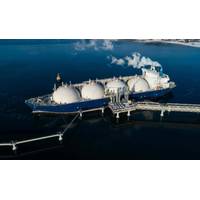Libya Arrives for OPEC with Exports at a Trickle
Libya's attendance at Wednesday's OPEC meeting will be an oddity for historians of the oil exporters club - a member with virtually no oil for sale.
As it struggles with its worst crisis since the 2011 war that toppled Muammar Gaddafi, early talk of a swift resumption of output have given way to pessimism, leaving OPEC with a longer lasting hole of over one million barrels per day in its supply.
Production is below 200,000 barrels per day, Oil Minister Omar Shakmak said on arrival in Vienna on Monday for the meeting, a fraction of the 1.6 million bpd Libya pumped before the 2011 conflict.
"Until the government gets control it cannot export on a normal basis... It is unlikely Libyan oil production will increase significantly in the next six months," said Charles Gurdon, managing director of Menas Consulting.
"Most of 2014 will effectively be written off."
The near absence of Libyan oil from international markets has helped anchor prices in a narrow range around $110 a barrel. That is a comfortable level for OPEC and few expect the cartel to change its output target for the rest of the year.
Rebels have blocked Libya's major ports and fields since last summer, slashing output.
With a renegade general launching war on Islamists, successive prime ministers struggling for legitimacy and a lack of oil revenues, the caretaker government could be forced to divert what barrels were destined for export to domestic refineries to supply gasoline to the capital.
Foreign oil companies have pulled out staff and frozen exploration activities, while Libya's hungry European customers have turned elsewhere for more steady supplies.
Monday's court ruling resolving a standoff between rival governments was welcomed by rebels holding some of Libya's largest oil terminals at Es Sider and Ras Lanuf and raises hopes that a deal to restore key export facilities could be reached soon.
But even if a deal to reopen all the ports and fields is made, industry insiders and officials from Libya's National Oil Corp (NOC) say it is hard to tell how much damage the closures have already caused to its precious oil infrastructure or how long it would take to return to prewar capacity.
Libya's western El Sharara oilfield may take months to reach its full output of 340,000 bpd, for instance, because at least 20 damaged well pumps need to be replaced.
Once output can build up, the damage is taking its toll on the country's production capacity. The International Energy Agency, the West's energy watchdog, in May cut its estimate of Libya's sustainable output capacity to 1 million bpd.
Fires on pipelines elsewhere and lack of maintenance could make resumption of exports a long and costly process.
Technically, Libya can still pump upwards of 1 million bpd but the new NOC chairman Mustafa Sanallah said it would only ramp up exports gradually - and in cooperation with OPEC. That would help avert a sudden slide in oil prices.
"From a technical point of view, our facilities are ready ...and our people can resume production very soon," Sanallah told a Libyan oil conference in London last month.
"But in order to resume production, we have to agree with our rivals, partners and with OPEC. We have still high storage of oil... So we have to export our oil gradually and by good cooperation between Libya and OPEC."
At a London conference last month on on Libya's energy sector presentations focused on plans for a new oil law, enhanced oil recovery and even pipeline upgrades, skirting around the fact that the state could not even guarantee the flow of oil.
"It is a very difficult market to predict," said Eric Oudenot, of Boston Consulting Group. "Nobody is really able to craft a strategy for Libya as it is too unstable."
(By Lin Noueihed and Julia Payne; Additional reporting by Ulf Laessing in Tripoli, Alex Lawler in Vienna; Editing by William Hardy and Veronica Brown)





